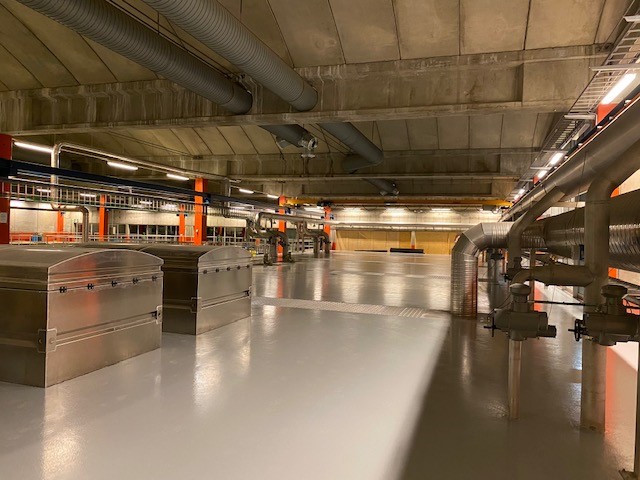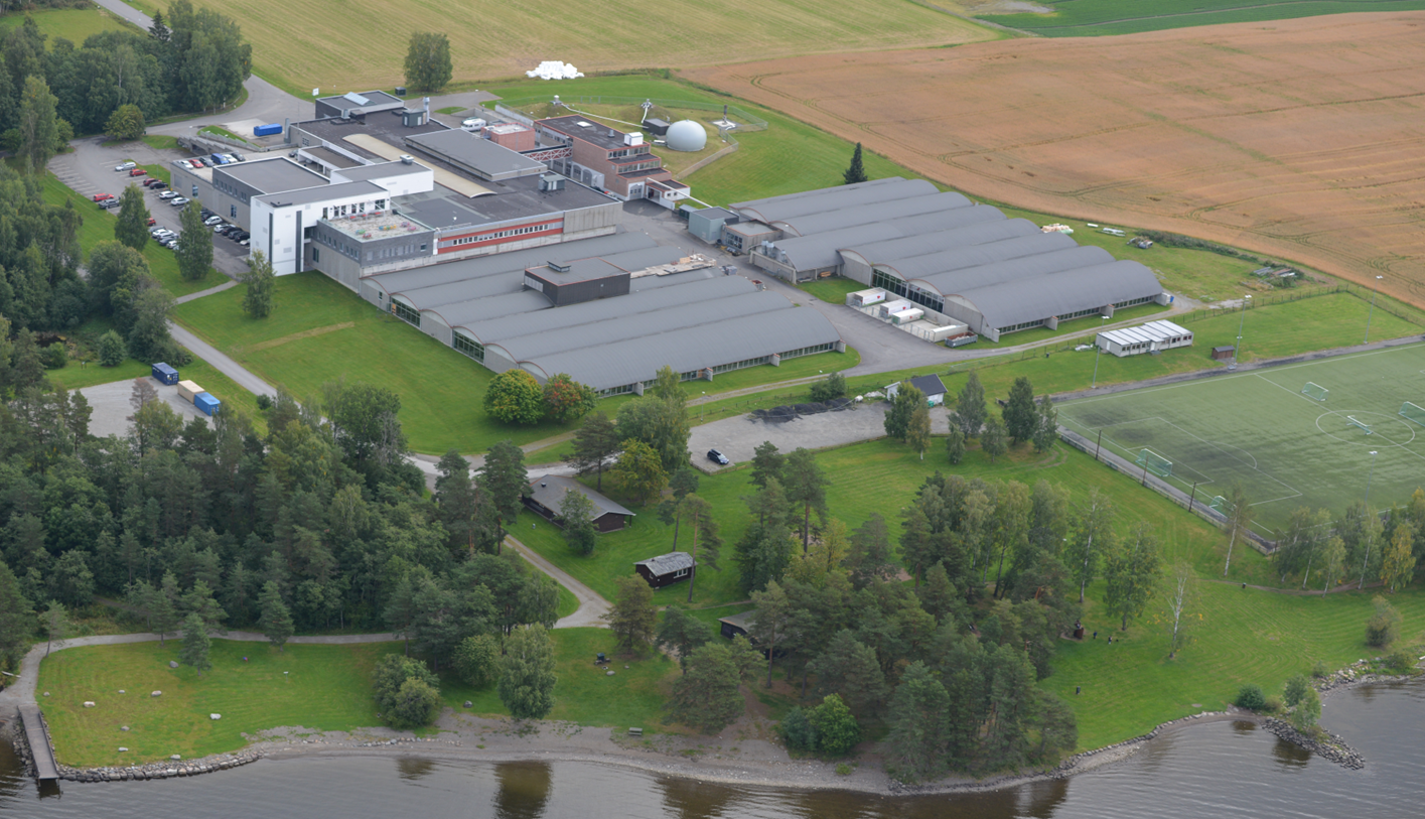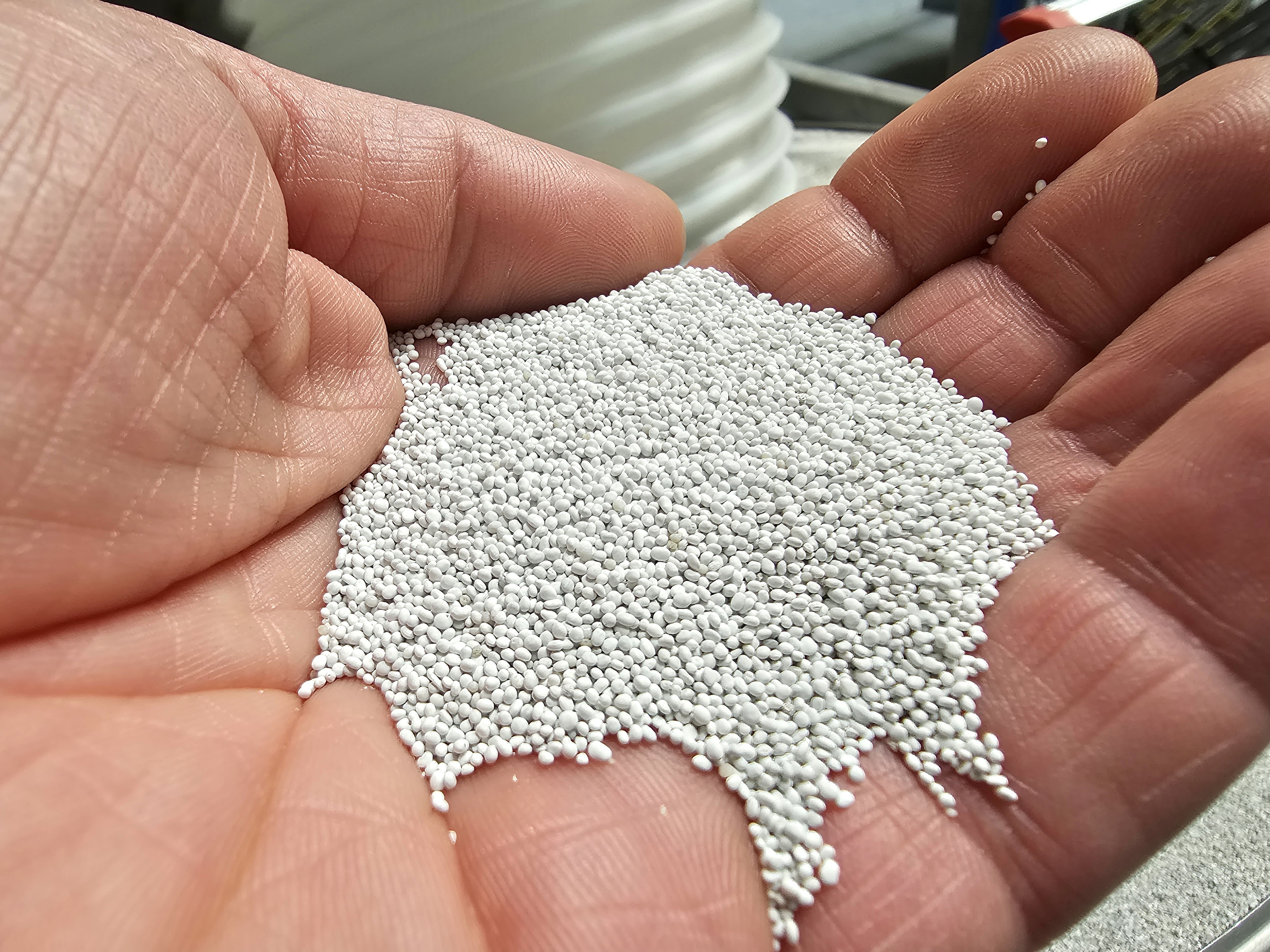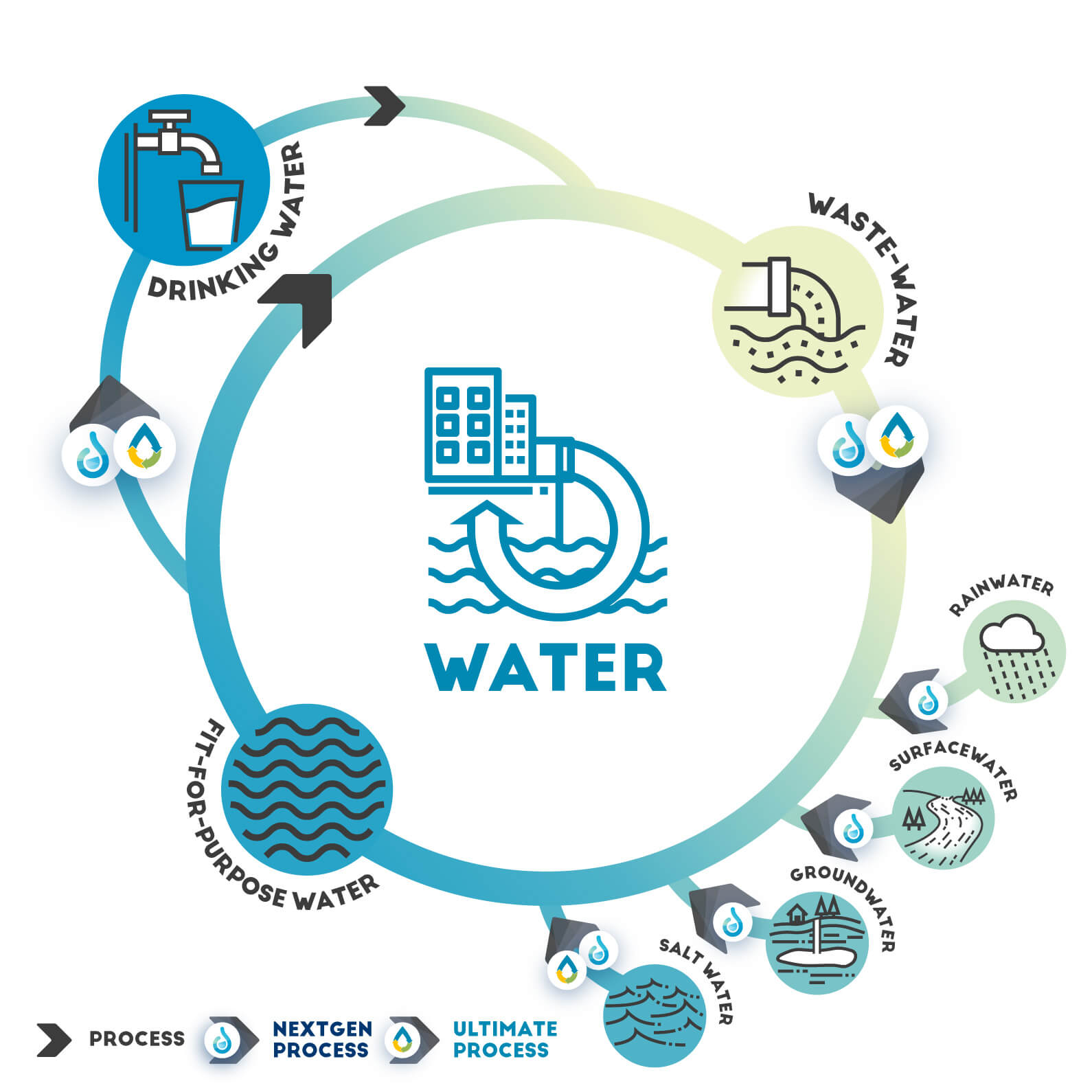Description
Hias IKS is an inter-municipal company that serves as the facility owner and service provider for the municipalities of Hamar, Løten, Ringsaker, and Stange in the areas of water and wastewater. In this part of the brochure, a presentation of the wastewater treatment, which the company is responsible for, follows.
Hias operates the wastewater treatment plant in Sandvika, which includes approximately 140 km of transfer pipelines, 11 pumping stations, and six measuring stations. The municipalities themselves are responsible for their wastewater networks, while Hias is responsible for the main supply to the wastewater treatment plant, including measuring stations and pumping stations. The wastewater volume from each municipality is measured when it enters Hias' network.
The wastewater from about 65,000 people, in addition to wastewater from industry and commercial activities, is directed to the treatment plant in Sandvika. A significant portion of the wastewater from the food industry results in a large influx of organic material. Industrial activity is seasonal, leading to times when the treatment plant experiences a significant load
At Hias the biological treatment of the WWTP was overloaded and the capacity needed to be increased. At the time there was signals regarding new regulations of phosphorous content allowed in treated sludge being used in agriculture. Hias wanted to reduce phosphorous content in the sludge to make sure agricultural disposal still was a viable option in the future.
The Hias-Process is biological nutrient removal in a continuous biofilm process. It combines MBBR and EBPR where the wastewater has a single pass and only the biofilm is returned by mechanically transferring the biofilm carriers from the end to the beginning of the process.
At Hias WWTP the main negative impact on sustainability and obstacle to circularity was identified as chemical precipitation for removal of phosphorus. The environmental footprint of coagulant fabrication, their transport, the chemical sludge produced, and the limited plant availability of phosphorus bound to precipitation chemicals have all adverse effects on sustainability.
Hias WWTP has an ambition of minimal use of metal coagulants and thereby achieving maximum phosphorus recovery as struvite and high plant availability of phosphorus in our biosolids or sewage sludge.
The main goals for Hias are to demonstrate the novel continuous biofilm EBPR process in combination with P recovery. The Hias-Process is biological nutrient removal in a continuous biofilm process. It combines Moving Bed Biofilm Reactor (MBBR) and Enhanced Biological Phosphorus Removal (EBPR) where the wastewater has a single pass and only the biofilm is returned by mechanically transferring the biofilm carriers from the end to the beginning of the process.
Applied technology
Key performance indicators
Reduction of use of precipitation chemicals of 62 % from 2018 to 2022.
The installation of MBBR EBPR started in 2019 and finished in 2021, so comapring 2018 with 2022 gives a comparison of activated sludge with The Hias process
Synergistic benefits
The Hias process and struvite production go hand in hand. The MBBR-based EBPR has reduced our use of chemical precipitation and generated a sludge stream of biological sludge. After concentration by a disc filter, it releases PO4-P when subjected to anaerobic conditions. When this stream is combined with the NH4-N-rich final dewatering stream and magnesium is added, struvite is produced.
Requirements and conditions
There are numerous challenges associated with phosphorus in wastewater, sludge, and sludge disposal. Phosphorus is a scarce resource on our planet, and therefore, it should be recycled as much as possible from wastewater or in the sludge returned agricultural land.
The current Norwegian practice of spreading sludge with large amounts of more or less unavailable phosphorus is not sustainable. In the future, new requirements for wastewater treatment and sludge management may be imposed.
There has been a significant focus on phosphorus emissions from agriculture. Phosphorus should not be added to agricultural areas that already have high levels of phosphorus in the soil. Thus, it would be highly advantageous to remove as much phosphorus as possible from the sludge before spreading it on farmland. Instead, the phosphorus could be used as fertilizer on land that actually needs it. Farmers are interested in the sludge primarily for its soil improvement properties (organic matter) rather than its phosphorus content. As a result, the demand for sludge without a high phosphorus content is not likely to decrease. When phosphorus is precipitated with iron or aluminium, it becomes strongly bound and less available to plants. Research conducted by the University for Environment and Life Sciences suggests that phosphorus from sewage sludge can still be washed out from agricultural areas, leading to eutrophication in nearby water bodies.
Sludge from biological phosphorus removal will release phosphorus more easily to plants. However, it is challenging to remove enough phosphorus solely through biological methods to meet stringent Norwegian discharge requirements.
Biological phosphorus removal also places specific demands on sludge management. In biological phosphorus removal, much of the phosphorus will return to the water phase during anaerobic sludge treatment. One possibility is to precipitate the phosphorus through struvite precipitation from the reject water after sludge dewatering. This could yield sludge with lower phosphorus content for soil improvement and a separate product with phosphorus that can be used for plant production.
However, a challenge to achieve a high level of phosphorus recovery with struvite precipitation is that the phosphorus removal should be performed without aluminium/iron chemical precipitation. With such an approach, it may not be possible to comply with the strict purification requirements set for Hias, and chemical precipitation may still be necessary. The chemical sludge affects the results of struvite precipitation, resulting in lower phosphorus recovery as struvite.
Anaerobic treatment of sludge in digestion tanks typically returns some phosphorus in the form of dissolved return flows from dewatering. When using pure biological phosphorus removal (without chemical precipitation), the precipitation of phosphorus from the return flows can be achieved through struvite precipitation. In struvite precipitation, magnesium is added to the wastewater, leading to the formation of magnesium ammonium phosphate (struvite, MgNH4PO4), which can be used as fertilizer in agriculture.
In the process, the reject water is precipitated in a crystallization reactor with the addition of magnesium chloride and pH adjustment. It is crucial to remove most of the phosphorus from the return flows, as struvite precipitation in centrifuges, pumps, and pipes can cause significant operational issues and is challenging to remove.
This method can achieve huge phosphorus recovery (of the biologically removed phosphorus), but the effectiveness requires using mostly biological removal and not chemical precipitation in the treatment plant. Chemically precipitated sludge will affect the results, reducing phosphorus recovery as struvite product. If extended biological phosphorus removal is combined with chemical precipitation, there will be free iron or aluminium molecules in the sludge. These molecules will react with the dissolved phosphorus in the biological sludge, binding it to the metals and making some of the phosphorus less accessible to plant growth. The presence of these free iron or aluminium molecules will also make it more difficult to achieve struvite precipitation in the return flows at the treatment plant because they will compete with magnesium chloride for the dissolved phosphorus molecules. As a result, the phosphorus may become more strongly bound in the sludge and less available for plant growth.
Applied products

Hias Process
Not published

The WIDER UPTAKE roadmap guide
The WIDER UPTAKE roadmap guide, developed by the H2020 WIDER UPTAKE project, offers a comprehensive framework for imple…
Publications and references
-
Estimation of effluent nutrients in municipal MBBR process. Komulainen, Tiina & Baqeri, Abdul & Nermo, Einar & Keprate, Arvind & Saltnes, Torgeir & Jansen, Katrine & Korostynska, Olga. (2023). Scandinavian Simulation Society. 286-293. 10.3384/ecp200037.
-
Spatial fractionation of phosphorus accumulating biofilm: stratification of polyphosphate accumulation and dissimilatory nitrogen metabolismSpatial fractionation of phosphorus accumulating biofilm: stratification of polyphosphate accumulation and dissimilatory nitrogen metabolism
Biofouling The Journal of Bioadhesion and Biofilm Research · Feb 24, 2022Biofouling The Journal of Bioadhesion and Biofilm Research · Feb 24, 2022 -
Effects of struvite application on soil and plants: a short‐term field studyEffects of struvite application on soil and plants: a short‐term field study
NORSØK report,Vol. 4 No. 10 2019 · Jan 1, 2019NORSØK report,Vol. 4 No. 10 2019 · Jan 1, 2019 -
Microbial ecological processes in MBBR biofilms for biological phosphorus removal from wastewater Microbial ecological processes in MBBR biofilms for biological phosphorus removal from wastewater
Water Sci Technol (2019) 79 (8): 1467-1473 · Jan 1, 2019 Water Sci Technol (2019) 79 (8): 1467-1473 · Jan 1, 2019 -
Forsøk med fosforgjenvinning i struvittreaktor ved Hias RA i 2017Forsøk med fosforgjenvinning i struvittreaktor ved Hias RA i 2017
Tidsskriftet VANN (2018) Utgave: 3 · Jan 1, 2018Tidsskriftet VANN (2018) Utgave: 3 · Jan 1, 2018 -
Biological nutrient removal in a continuous biofilm process Biological nutrient removal in a continuous biofilm process
Water Practice and Technology (2017) 12 (4): 797-805 · Jan 1, 2017Water Practice and Technology (2017) 12 (4): 797-805 · Jan 1, 2017 -
Potensialet for biologisk fosforfjerning ved norske renseanlegg Potensialet for biologisk fosforfjerning ved norske renseanlegg
Tidsskriftet VANN (2016) Årgang: 51. Utgave: 2 · Jan 1, 2016 -
Kontinuerlig biofilmprosess for biologisk fosforfjerningKontinuerlig biofilmprosess for biologisk fosforfjerning
Tidsskriftet VANN (2014) Årgang: 49. Utgave: 4 · Jan 1, 2014Tidsskriftet VANN (2014) Årgang: 49. Utgave: 4 · Jan 1, 2014 -
Biologisk fosfor- og nitrogenrensing med Hias prosessenBiologisk fosfor- og nitrogenrensing med Hias prosessen
Tidsskriftet VANN




